I am posting this very nice compilation of Archive Films and Photos of Ramana Maharshi produced by Arjuna Deva. If you can not see anything, please enable 'cookies' on your browser at Tools>Internet Options.
9 December 2006
Ramana Video
I am posting this very nice compilation of Archive Films and Photos of Ramana Maharshi produced by Arjuna Deva. If you can not see anything, please enable 'cookies' on your browser at Tools>Internet Options.
Cultural Programme
In a previous post I mentioned the extraordinary work being done by the Rangammal Memorial Rehabilitation Society set up by Sylvia Wright. As part of that Society, in 1992 The Rangammal Memorial Higher Secondary School for the Hearing Impaired was established here in Tiruvannamalai. The school has a high reputation for academic and cultural excellence. It is totally free of cost and currently has 200 residential and 36 non-residential pupils. There is no charge for food, board or study books.

I recently returned on a second visit to the school and spent some happy time with the children and staff. During my visit I was able to watch the children practise a dance routine they were preparing for a cultural function associated with 'The World Disabled Day' to be held December 3rd at Chennai.
In the below photograph the children are preparing different sequences of their programme. Both the youngest and the oldest at the school are being represented. The children are wearing their school clothes, but I was assured by Madam Krishnabai (the Headmistress of the school) that very colourful and elaborate costumes were being prepared for the kids to wear during their programme at Chennai.
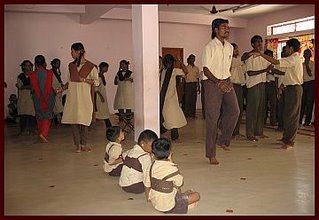
I sat and watched the whole routine the kids were preparing. Of course I (like the audience in Chennai), watched the children perform to music. Their movements and gestures were so perfectly timed to music that it was difficult to believe that most of them are completely deaf. It was a joy to watch their happy, jubilant faces while they were dancing. One teacher sat in front of the children with a large drum and the kids took their cues from the timing of the beating of the drum and also from various hand signals made by the teacher. It was a truly breath-taking performance.

A total of 65 children representing Rangammal Memorial Higher Secondary School for the Hearing Impaired travelled to Chennai to participate in the programme. Needless to say the kids won and after a brief stay at Chennai returned triumphantly to Tiruvannamalai with their trophy shield and wonderful memories.
Transformer Failure

The prolonged failure of an electric transformer at Vedanthavadi village, Tiruvannamalai District, has left around 200 acres of paddy and peanut crops to wilt as irrigation motors have came to a halt for the last two months.
The transformer, which feeds power to irrigation pumps in the village, developed a snag two months ago and since then power supply remained disrupted resulting in crops withering without water, said villagers.
When village members contacted the Electricity Board, they were told that it would take another 15 days for the transformer to get repaired. Since there is no power supply in the line to the pumps, burglars have been stealing the electric cables.
This sad story is very much a throw-back to yesteryear. My own experience is that the infrastructure in this area has improved immensely. However, one does get isolated rural pockets that perhaps have (thus far) not benefited as much as their urban brethern. Overall things are getting better here and perhaps worse in more developed countries. We are certainly experiencing changing times as it seems like even Western countries are no longer able to rely on the effective working of their own infrastructure.
8 December 2006
Wonderful World
[To view this page please enable 'cookies' at Tools>Internet Options on your browser bar]
What It Is: Arunachala
[To view this page please enable 'cookies' at Tools>Internet Options on your browser bar]
Virupaksha Cave
Of all the caves on Arunachala undoubtedly Virupaksha Cave and Skandashram Cave are the most famous. Of the spacious Virupaksha cave it is of extraordinary importance in the history of Arunachala. From time immemorial this cave has been occupied by Saints and Siddhas but the actual name of the cave comes from Sri Virupaksha who hailed from Mallikarjuna, in the neighbouring State of Andhra Pradesh.
It is believed Sri Virupaksha occupied the cave during the same time period in the 6th or 7th Century that the great Namasivaya and Guru Namasivaya lived in adjacent caves lower down the Hill.
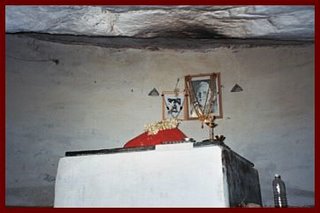
Virupaksha performed great penance in his cave and when he attained liberation he left his body reduced to a heap of aches on the cave floor (the ashes are reportedly now placed under a brick dome on top of a rectangular pedestal facing the entrance).
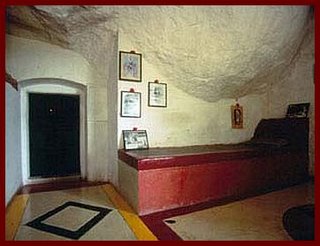
There is a space with a bench-bed (built by Sri Ramana himself) in the front of the cave. Ramana Maharshi lived I this cave from 1899 to 1916 during hot summers he would move to the cooler Mango Tree Cave and in 1916 Bhagavan and his devotees moved up to the larger Skandashram.

Nowadays the Virupaksha Cave is managed by Ramanashram and thus kept in good order. It is open throughout day hours and many pilgrims take the opportunity to meditate inside the cave. It is reported by many that the energy and power in Virupaksha Cave is so intense that it is difficult to meditate there for long periods of time.
Arunachala Friends
AKSP Report
Two consecutive years of good rains the like of which have not been seen by Arunachala for decades has made the Hill this Deepam, 2006 present a luscious luxuriance unprecedented at least within the last thirty years.
For three months leading up towards Deepam, rain has fallen most days. Locals of the unsophisticated culture see this wetness and discomfort as a sure sign that Arunachala Siva very much likes his new green 'duds' better than the old brown ones, even if 'It' is the Fire Lingam of South India!

We have not had an appreciable fire for two summers, thanks to the community participation fostered very largely by our two District Forest Officers (DFOs), Messrs. Pasupathiraj and Mani, who have recently been transferred and were tremendously encouraging and helpful to all engaged in the Greening of Arunachala. In fact The Arunachala Kattu Siva Plantation owes its very existence to these excellent DFOs.
Arunachala now has a new DFO (District Forest Officer), Mr.Yuvalraj. Mr.Yuvalraj will be promoted to Conservator around this time next year, which means that he will be sent elsewhere within a year from now. Then it will be opportune for us to meet the incoming DFO, introduce our project, and request him to encourage and support us. Our continuance is always dependent upon the discretion firstly of our local DFO, secondly of our Conservator in the Divisional Headquarters in Vellore, and thirdly of our Principal Chief Conservator in Chennai.
This is the way it has to be because forests are so desperately in need of protection, not only just at Arunachala and in India, but also internationally; Forests are our lifeline.
The Arunachala Kattu Siva Plantation has permission to plant on the Hill within the area designated Reserve Forest; this area is off-limits to other than Forestry Department personnel unless special permission is given. Very Good Reasons promote this structure. Within this special permission which we have been given, we in turn honour the original, cognitively competent considerations behind it. The Arunachala Kattu Siva Plantation is very happy to be planting on Reserve Forest because in this way we are enabled to work without disturbance.
Nevertheless, if we re-forested the entire hill, with a forest that flourished for decades and replenished the underground water table to surface level, then despite our intentions on behalf of the generations to come: within ONE summer night the entire forest could EASILY, be destroyed by one match at the hand of ignorance.
No matter how green we see the garments of Arunachala Siva from year to year, we just have to remember that in the summer months of the climate of the Fire Lingam, when 'Its' body is tinder and there are many excuses for arson, all could well be lost within one night and all the efforts towards the Greening would be rendered pure unadulterated vanity.
[By Apeetha Arunagiri]
For more information about the Arunachala Kadu Shiva Plantation and Apeetha Arunagiri please check out their link at: http://www.aksp.org/
7 December 2006
Horse Fair
Traders and brokers, who thronged with different horses to the market, attributed the diminishing trade to the depletion of the horse population in the State, as horse chariots, once a popular mode of transport, are becoming obsolete giving way to two wheelers and automobiles
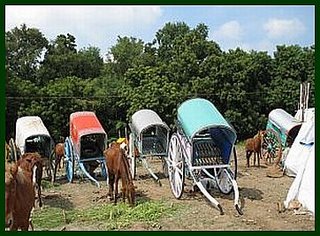
"The number of horses that arrived to the shandy this time, is around 500, when compared to around 2,000 horses, a few years ago," recalled a Tiruvannamalai-based horse trader. Horses from areas such as Gudiyatham, Ambur, Cuddalore, Chidambaram, Mayavaram, Salem, Erode, Harur and Mathanappalli were brought to the Tiruvannamalai Bullock and Horse fair, however sales was not encouraging.
A trader from Ambur said he was the last chariot-operator from his town, but as everyone now opts for auto rickshaws, he wanted to get rid of his business. Another trader from Guidiyatham complained that a tax of Rs.120/- for each horse was charged at entry points into town. Many traders feel exorbitant charges are detrimental to the fair which assembles once a year. Increase in transportation expenses and local taxes also added to the woes of the traders.
However such tourist areas in Tamil Nadu as Kodaikanal still rely on horse driven chariots as a mode of transportation. Horse riding and rearing also has followers in the State. The price for a young horse is around Rs.4,500/- (U.S.$100) and for an older one Rs.7,000/- (U.S.$160).
The Government has organised a free medical camp near the shandy for treating ailing cattle and administering vaccines to horses and cows for diseases such as foot and mouth and anthrax.
Mooji Retreat
Mooji visits India at least once a year sharing satsang. This year, a silent Retreat will be held from 7th to 24th December 2006 in Tiruvanamalai at venue Sri Nannagaru Ashram. The Retreat will be followed by satsangs in January 2007 which will be open and free to all. Information will be posted on this Blog regarding details of the open satsangs.
Mooji was born Anthony Paul Moo-Young January 29th, 1954 in Port Antonio, Jamaica. In 1969, he moved to the UK and is presently living in Brixton, London. Mooji is a direct disciple of Sri Harilal Poonja, the renowned advaita master, or Papaji, as his followers call him.

Since 1999, Mooji has been sharing satsang in the form of spontaneous encounters, retreats, satsang intensives and one-to-one meetings with the many seekers who visit him, from all parts of the world, in search of the direct experience of truth.
Mooji shares satsang in Brixton, London, where he lives. He also travels regularly to Ireland, Wales, Italy and India where he conducts satsangs and retreats.
http://www.mooji.org/
5 December 2006
Chockapaanai
As part of the celebrations during Karthigai Deepam, people in the evening, throng to witness the lighting up of the 'chockapaanai'; in which the stems of dry palm, coconut and kamugu are burnt symbolising famine and drought be removed from society.
Some believe that the remains of 'chockapaanai', which are placed along the pathway of agricultural land is a symbol of prosperity. Palms which are well-known and extensively cultivated, have always had an important role to humans. According to reports, had the date palm not existed, the expansion of the human race into hot and barren parts of the world would have been much more restricted.

The date palm provides a concentrated energy food and also creates an amenable habitat for people to live in by providing shade and protection from desert winds. The date palm also yields a variety of products for use in agricultural production and for making baskets, trays and for decoration. Practically all parts of the tree serve some useful purpose or the other.
An indication of the importance of palms is that they are mentioned more than 30 times in the Bible and at least 22 times in the Koran.
Human use of palms is as old or older than civilisation itself, starting with the cultivation of the date palm by Mesopotamians and those in the Middle-East over 5,000 years ago. Some examples are of Rattan (a climber of Sri Lanka and Southern India), whose stems are used extensively in furniture and baskets and Palm sap which is sometimes fermented to produce the alcoholic beverage, palm wine or toddy.
Unfortunately, palms have been threatened by human intervention and exploitation. The greatest risk is destruction of habitat, especially in the tropical forests, due to urbanisation, wood-chopping, mining, and conversion to farmland. Palmyra, which is declared as the 'State Tree' of Tamilnadu, helps prevents soil erosion and protects natural wealth especially during disasters like tsunami.
As per Tamilnadu Palm Products Development Board's 15-point programme, awareness is being created not only as to the nutritious value of the edible products of the palm, but also to develop and fully utilise an industry of palm products.
[By R Gomathy Sankaravel]
Deepam Events
Earlier, Bharani Deepam was lighted inside the Temple on December 3rd, at 4 a.m., to symbolise the unification of the five elements (water, fire, earth, ether, air).Thickly packed devotees inside the Temple had a glimpse of light on the earthen lamp.
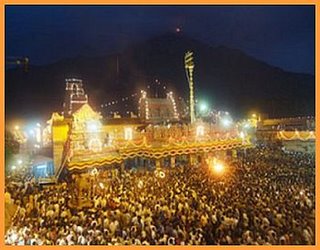
In the evening, the Festival began near the golden Flag Mast inside Annamailayar Temple. First, idols of Vinayagar, Murugar, Annamalayar, Unnamulayamman and Chandikeshwarar were taken out from the Temple and placed on the Mandapam in front of the flag mast.
Simultaneously, Aganda Deepam in front of the Flag Mast and five torches were lit. On seeing the lighted torches in the Temple, men at the peak of the mountain lit the Deepam Cauldron.
3 December 2006
DEEPAM 2006
For your enjoyment this Deepam day a compilation of photographs to show the sequence of events that lead to the lighting of the Deepam on the top of Arunachala each year.
Early in the morning of the lighting of the Deepam Cauldron, hordes of pilgrims start their trek up the side of Arunachala so they can witness the actual lighting at dusk. Many bring ghee (clarified butter) which is the only fuel used inside the Cauldron, as an offering to the Sacred Hill. From down below it is easy to watch the column of devotees climb up the Hill.
Men, women, and children make their way up the slope. The first day, the actual lighting, is the most popular but in fact all through the 10 days the Cauldron will be kept alight, pilgrims climb the slope with the ghee that they personally wish to offer to the Flame on Arunachala.

Some bring small packets of ghee, others bring enormous tin containers. The top of the Hill near the cauldron is slippery and slick from the empty containers and spilled ghee.

Swathes of cloth are soaked in ghee and packed tightly into the Cauldron. The cloth will be the wick for the giant light.
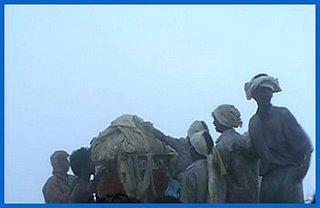
Once the ghee saturated cloth has been wound and packed into the Cauldron then blocks of camphor (the lighting agent) are smashed into crevices and openings left by cloth folds.

The taper then needs to be prepared. The actual light itself has been brought up that morning from the Arunachaleswarar Temple.

Finally its time to light the giant vat with the taper, which itself has been lit by the flame brought up from the Arunachaleswarar Temple.
The crowd is densely packed at the top of the Hill and its hot and risky to be so close to the Cauldron. But the fervour and devotion of the pilgrims is such, that such matters as health or safety are hardly considered.
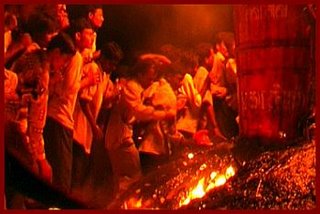
The brilliant flame blazes upward and outward.
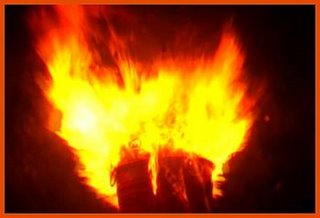
From down below we view Arunachala Deepam Beacon 2006, which was lit at dusk this evening, December 3rd at around 6.05 p.m.

Deepam Peace
Deepam Eve
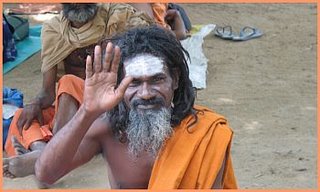
There are always thousands of sadhus and sannyasins visiting or staying at Arunachala at any one time. But for Deepam there is a positive innudation of sadhus coming to Arunachala from all over India.
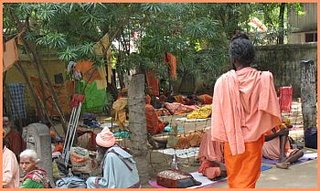
As well as food for the spirit, there is also plenty of food for the body too! Hundreds of mobile tent kitchens have been set up and also stalls selling favourite eatables are packed around the outer pradakshina pathway.
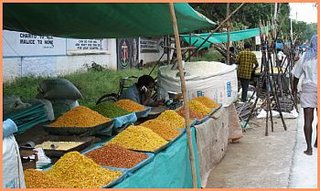
There is a joyous and jolly atmosphere in the air. Even the packed lorries coming into town with pilgrims from afar are filled with happy, waiving visitors.
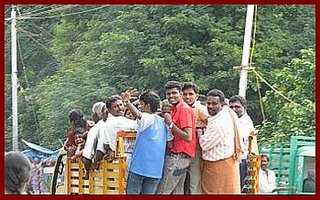
Every year during the Deepam Festival, Tiruvannamalai plays host to a large cow and pony fair. During which farmers from all over Tiruvannamalai District bring their working bullocks and ponies for market.

Hawkers of all sorts of bric-a-brac roam the streets on the lookout for customers to purchase their items.

Fruit wallahs wait by the roadside next to their mounds of green coconut, sugarcane and bananas.

The vendors and shop owners are ready. They have planned well. Preparations are complete. Everything is in place. They only await tomorrow and the million expected for the day of Deepam and the lighting of the flame on top of Arunachala.
Toll collections
Devotees from Krishnagiri District have asked that stern action be taken on persons involved in illegal vehicle toll collections, the day of Karthigai Deepam festival.
Every year, crowds of people from various parts of the country throng Tiruvannamalai on the eve of Deepam festival, to be celebrated today, December 3rd.
It was estimated that around 100,000 from Krishnagiri, Dharmapuri and Salem Districts attended Deepam Festival last year. All of whom have to pass through Krishnagiri, Bargur, Uthangarai and Chengam to reach Tiruvannamalai.
Devotees from Krishnagiri complained that unscrupulous people collect illegal toll from vehicles entering Tiruvannamalai from Krishnagiri District every year. Unauthorised people stop private vehicles anywhere between Chengam and Tiruvannamalai and collect Rs.50/- to Rs.150/- (U.S.$1.20-$3.50) per vehicle. Sometimes, they also collect money from vehicles parked at the entrance of Tiruvannamalai without issuing proper receipts.
It was understood that these offenders manage to collect around Rs 20 Lakhs (U.S.$45,000) by this illegal collection every year. Devotees from Krishnagiri District have contacted Municipal representatives of Tiruvannamalai District in this connection and have asked them to prevent illegal toll collections from vehicles this day Sunday (December 3rd).
Juggernaut
On an earlier post on this Blog:
http://arunachalagrace.blogspot.com/2006/11/deepam-calendar.html
all the processional events at Arunachala during Deepam were listed. The major procession of the Juggernaut carrying representations of the five deities and pulled by devotees around the perimeter roads of Arunachaleswarar Temple (a feat which can take upward of 12 hours) always takes place on the 7th day of Deepam Festival. This is the grandest and most fervent procession of the entire festival.
The first night of the lighting of the flame actually takes place on the 10th day of Deepam and stays alight for between 8-10 days. However the Festival itself lasts for 13 days. Of these the first 3 days occur in Durgai Amman Temple and the remaining ten days in Arunachaleswarar Temple. Each day denotes different functions and ceremonies at either the Durga Temple, the Arunachaleswarar Temple or in the streets surrounding them.
The Deepam festival follows the moon calendar so each year the date is different however it always falls when the star Krittika is in conjunction with the Moon in the month of Karthika (November-December). To find out the dates of upcoming Poornimas (full moons) and Deepams through to the year 2009, please check the following link:
http://www.arunachalasamudra.org/fullmoon.html
The seventh day of this year's Deepam fell on November 30th and down below are photographs showing you some of the devotion, fervour and fun of what is considered the grandest procession of the Deepam Festival.
Tiruvannamalai wakes early ready for the grand event.

Its cool and moist early morning in this damp wet season.

Here the giant car, the Juggernaut majestically and slowly is being pulled with iron chains by hundreds of devotees.

A young local lad blows on his conch and joins the sounds of cheers, music and the calls of the crowd all converging around the giant float carrying representations of five deities around the huge perimeter of the 26 acre Temple.

Here is a wheel of the giant float. Young men push levers underneath its wheels whenever the Juggernaut grinds to a halt. Once the lever is in position men and boys jump gleefully on the lever to impel the float forward.

On the left side of the Juggernaut the iron chains towing the vehicle are pulled by ladies and on the right side, by men. To be involved in the procession of the five deities on the Juggernaut is regarded as a great blessings by all locals.

People are waiving from roofs, jammed on balconies and tucked away at any vantage point they can find to watch the majestic, slow progress of the giant vehicle through the main streets of Tiruvannamalai around the perimeter of the Arunachaleswarar Temple. This journey of circumbulation can in fact take up to 12 hours.

Another view of the giant float which is populated with swarms of men and lads.

One of our worthies trying to keep law and order in the chaos of the Festival. There is not too much in the way of crime to worry about, the concern is more about trying to keep some kind of flow and movement going on in the City. This year over 6,000 police have been drafted from surrounding areas to come into Tiruvannamalai during the Festival to secure the comfort and safety of devotees.

The journey is now almost complete and the Juggernaut is nearly home in its permanent garage outside the Arunachaleswarar Temple.

The seventh day of Deepam Festival is over for another year. And after the huge crowds and excitment of the procession of the giant float, the Temple and City sleeps.

30 November 2006
Sri Nannagaru's Visit
As is his usual custom Sri Nannagaru arrived at Arunachala today for his annual Deepam visit. We expect him to remain until about December 5th. Sri Nannagaru hails from a small place called Jinnuru near Bhimavaram which is in the heart of the rural district in Andhra Pradesh.

Sri Nannagaru first came to Arunachala in 1957 at the age of 21 years, in answer to a dream with Sri Ramana Maharshi. As Bhagavan died in 1950, Sri Nannagaru never in fact actually met with Ramana, but took him as his Guru. Sri Nannagaru attributes his realisation to the grace of Arunachala-Ramana.
I expect to visit his Ashram tomorrow, so will report back with news then. In the meantime you may like to check out Swami's website at: www.srinannagaru.com
Temple Cars
The wooden wheels of the Tiruvannamalai Temple cars that carry the idols of Lord Murugan and Vinayakar have been replaced with iron wheels which were made at the cost of Rs.3.72 Lakh (US$8,335) by BHEL, Tiruchi. The cars of Annamalayar and Unnamulayammai have already been fixed with iron wheels.
Arunachaleswarar Temple has five cars which will be pulled around the four Mada Streets during the Festival. This year, devotees donated ten ornamental umbrellas to the Temple which will be carried with the Deities on their procession.
A Chennai based textile house has donated Rs.1 Lakh (US$2,240) of cloth to be used as covers for Temple cars.
Earthen Goblet
[conversation between the poet and goblet]
O silent goblet! Red from head to heel,
How did you feel
When you were being twirled
Upon the Potter's wheel
Before the Potter gave you to the world?
I felt a conscious impulse in my clay
To break away
From the great Potter's hand
That burned so warm.
I felt a vast
Feeling of sorrow to be cast
Into my present form.
Before that fatal hour
That saw me captive on the Potter's wheel
And cast into this crimson goblet-sleep,
I used to feel
The fragrant friendship of a little flower
Whose root was in my bosom buried deep.
The Potter has drawn out the living breath of me.
And given me a form which is the death of me;
My past unshapely natural state was best,
With just one flower flaming through my breast.
[By Harindranath Chattopadhyaya]

